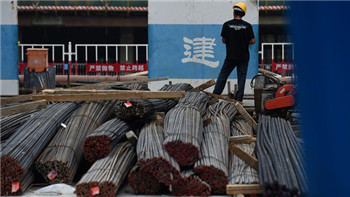(单词翻译:单击)

China’s economic planners pledged to adopt more “proactive” and “flexible” fiscal and monetary policies in the new year, the official Xinhua news agency reported yesterday, as the country looks poised to post its slowest annual economic growth rate in 25 years.
据官方的新华社昨日报道,中国经济规划者承诺在新的一年里采取更加“积极”和“灵活”的财政和货币政策。中国看来将取得25年来最慢的年度经济增长率。
The government will embrace more “accommodative” fiscal and monetary policies, said a policy official familiar with the planning, while reducing surplus production capacity, lowering costs for businesses and selling off stockpiles of properties and industrial goods.
一名熟悉规划事务的政策官员表示,政府将实行更加“宽松”的财政和货币政策,同时减少剩余产能,为企业降低成本,出售积压的房地产和工业产品库存。
“There will be fiscal policy to expand government spending and increase the government’s deficit,” the official said, adding that the economy “will follow an L-shaped path; it won’t be V-shaped”.
“将会有扩大政府开支和增加政府财政赤字的财政政策,”这位官员表示。他补充说,经济“保持‘L’型态势;不会是V型”。
China has struggled to reach its GDP growth target of “around 7 per cent” and recently said that it expected average annual growth to slip to 6.5 per cent over the next five years.
中国今年竭力要实现“7%左右”的国内生产总值(GDP)增长目标,官方最近表示,预计未来五年年均增长率将下滑至6.5%。
In a statement at the end of Beijing’s annual Central Economic Work Conference, the government said that “China’s current proactive fiscal policy needs to be more forceful, and the fiscal deficit ratio needs to be raised gradually.”
政府在一年一度的中央经济工作会议在北京结束后发表声明称:“积极的财政政策需要更加有力,财政赤字需要逐步提高。”
However, the planning, which focused on “supply side” reforms, may be met with scepticism by foreign investors who have complained that bold reforms promised two years ago have yet to materialise.
然而,以“供应侧”改革为焦点的规划,可能受到外国投资者的质疑,他们抱怨称,两年前承诺的大胆改革至今未能兑现。
While China’s overall debt-to-GDP level has soared past 250 per cent in recent years, largely due to excessive leverage in the corporate sector, the central government and local administrations can increase their borrowing to support the economy.
虽然中国的总债务与GDP之比近年飙升至250%以上(主要是由于企业部门的杠杆率过高),但中央和地方政府可以增加借款以支持经济。
After the financial crisis, local governments borrowed through specially created finance vehicles that invested heavily in infrastructure and property.
前些年金融危机爆发后,地方政府通过专门设立的融资工具借款,然后大举投资于基础设施和房地产。
“The [central government] will have larger fiscal deficits and allow local governments to issue more bonds,” said Chen Long, China economist at Gavekal Dragonomics. “Meanwhile, local government finance vehicles will be allowed to borrow at full speed.”
“(中央政府)将有更大的财政赤字,并允许地方政府发行更多债券,”龙洲经讯(Gavekal Dragonomics)中国经济学家陈龙表示。“与此同时,地方政府融资工具将获准开足马力借款。”
Chinese officials have argued that even as traditional economic engines such as property and infrastructure investment lose steam, consumption will make up for the reduced slack in the economy.
中国官员辩称,即使传统的经济引擎(如房地产和基建投资)失去动力,消费也将弥补经济中的松弛。
However, they admit that many of the most demanded products and services, especially in education and healthcare, are in short supply, leading to a need for “supply side” reforms.
但他们承认,许多需求最大的产品和服务(特别是在教育和医疗保健领域)供不应求,这意味着需要推行“供应侧”改革。
“There are a lot of unmet demands in the economy,” the official said. “We are not facing a lack of demand.”
“经济中有很多尚未满足的需求,”上述官员说。“我们并非面临需求不足。”
Like the “supply side” reforms by Ronald Reagan and Margaret Thatcher in the US and UK 30 years ago, Chinese officials have promised to cut red tape and lower administrative taxes. Many China-based manufacturers argue that in some areas they face costs comparable to, if not higher than, those in the US and Europe.
就像罗纳德里根(Ronald Reagan)和玛格丽特鈠切尔(Margaret Thatcher)30年前在美国和英国推行的“供应侧”改革那样,中国官员承诺削减繁文缛节和降低行政税费。许多在中国从事制造的企业提出,在某些地区,他们面临的成本与在美国和欧洲的同行不相上下,如果不是更高的话。
The Chinese government has, however, stopped short of embracing privatisation, with recent state sector reforms instead focused on reorganising existing state-owned enterprises.
然而,中国政府并未真正拥抱私有化,近期出台的国企改革方案专注于重组现有的国有企业。


